Homemade ginger wine is a light and refreshing drink for celebrations or regular days in. Using ginger root we make this spicy wine in 2 weeks and add a few optional ingredients for different flavors.
In my culture, making wine at home is a skill handed down from generation to generation. Using old ceramic jars that we call barnis, the ginger wine is made through a simple but regular process of stirring and straining over a two week period. The wine can be made in a shorter time frame, say 3 to 5 days. But to get the extra kick, we let it ferment longer.
Also, we don’t use citric acid, or campden tablets, or acid blends, or hydrometers or any other modern equipment. The wine tastes a lot better when it’s made the way our ancestors did, maybe even the way people in Jesus time did. Natural homemade ginger wine! Or not, maybe he just has natural grape or raisin wine. 😉
This ginger wine is a version of the traditional wine that I’ve modified quite a bit to lessen the sugar while maintaining the strength.
What do you need to make ginger wine at home?
Ginger root of course! And some sultanas or raisins, yeast, lemon juice, sugar and water. We also add optional flavors at different times – lemon skins, orange zest, or dried chillies.
EQUIPMENT YOU MIGHT NEED TO USE
- Barni (Traditional Ceramic Jar) or Demijohn or Fermentation bucket
- Wooden Spoon or Stainless Steel Spoon
- Sieve (strainer) or Muslin Cloth
- Pestle and Mortar
- Stainless steel pot
Steps to Make Homemade Ginger Wine
Please make sure it is legal to make homemade wine in your city or state before you try out this recipe.
Start by sterilizing your equipment – ceramic jars, demijohns, wooden spoons, etc – by washing them with boiling hot water.
Next, wash and clean the ginger. Then bruise it well with a pestle and add it to the demijohn or ceramic jar along with the lemon juice.
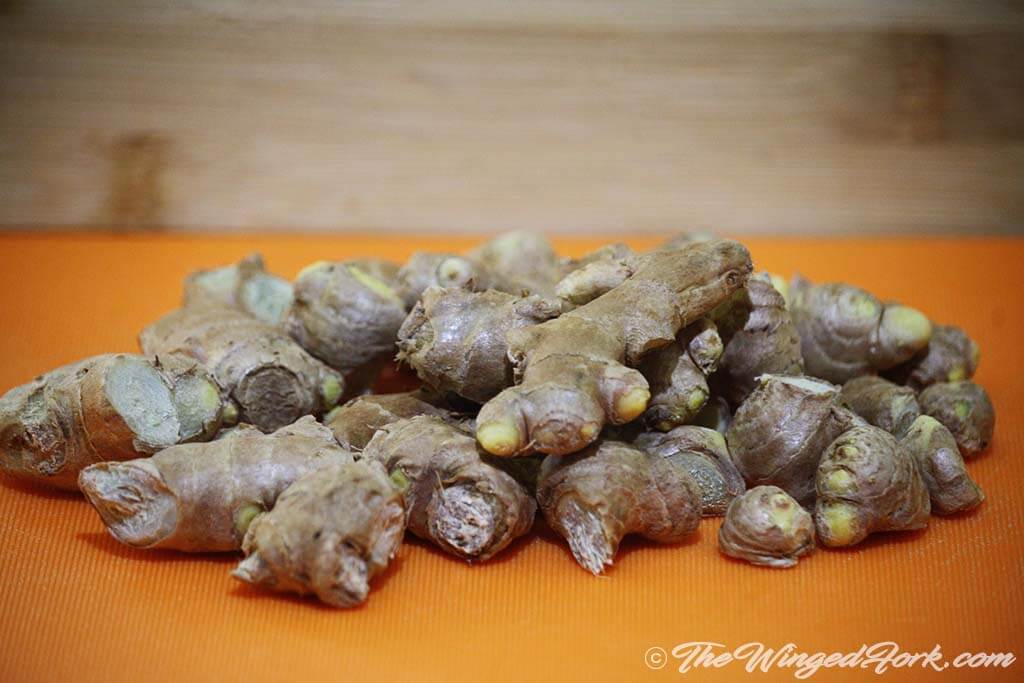
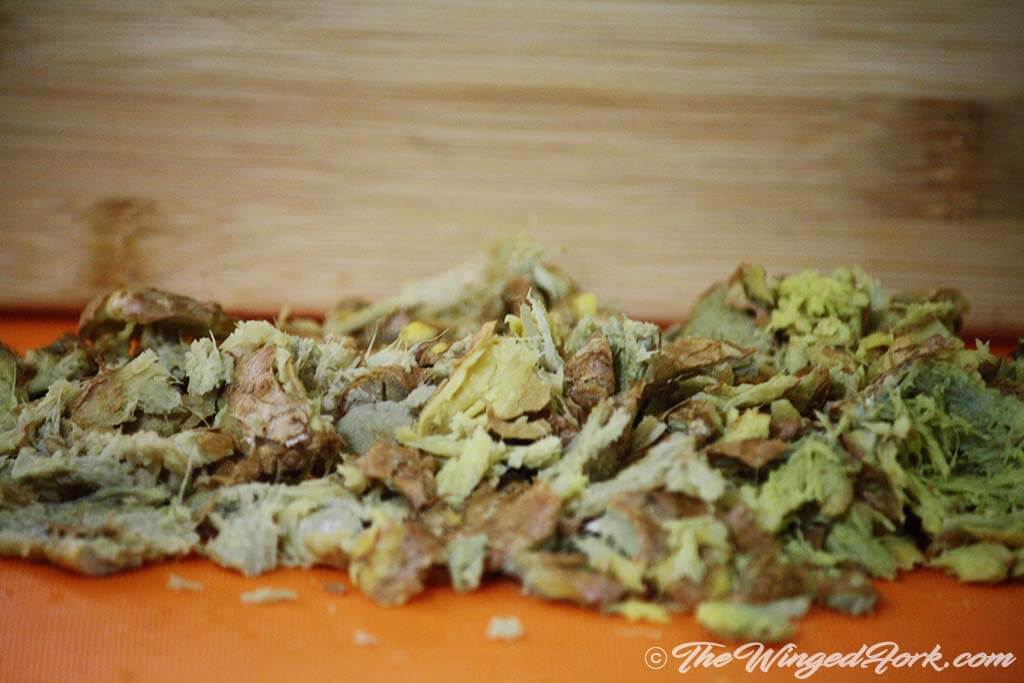
Cover the ginger with your sugar and raisins / sultanas. It doesn’t make a difference if you use raisins or sultanas. Both are good yeast nutrients and help you make a stronger wine. The only difference will be in the color of the wine you make. You’ll find a pic later in the post where we’ve made wine using only sultanas. It’s a darkish brown. But if you use raisins you’ll end up with a bottle of clear sparkling ginger wine. You can also skip the raisins or sultanas altogether, but then you’d have a wine that’s only about 3% to 5% strong.

Next, set aside about 100 ml of water to proof the yeast. Top up the ceramic jar with the rest of the water to make 4.4 litres. Proof the yeast with the 100 ml of lukewarm water add it to the barni (ceramic jar).
Alternatively, if you’re sure the yeast is active, you can just top up the jar to 4.5 litres of water and throw in the yeast. There’s no need to proof it. I’ve found that SAF Levure and DCL yeast are those type of yeast, so I use these quite often.
Use a wooden spoon, stainless steel spoon, or food grade plastic spoon to stir the must every day for the first week.

In this version, we used lemon skins for a light fruity flavor. At other times, we’ve used orange skins or dried kashmiri chillies. You can see that on the second day the must was fizzing wildly. I had taken a video to share, but all I could hear in it was the family talking about mustard chicken in the background. So no sharing this time. I’ll try to make another video the next time we make a batch of wine.

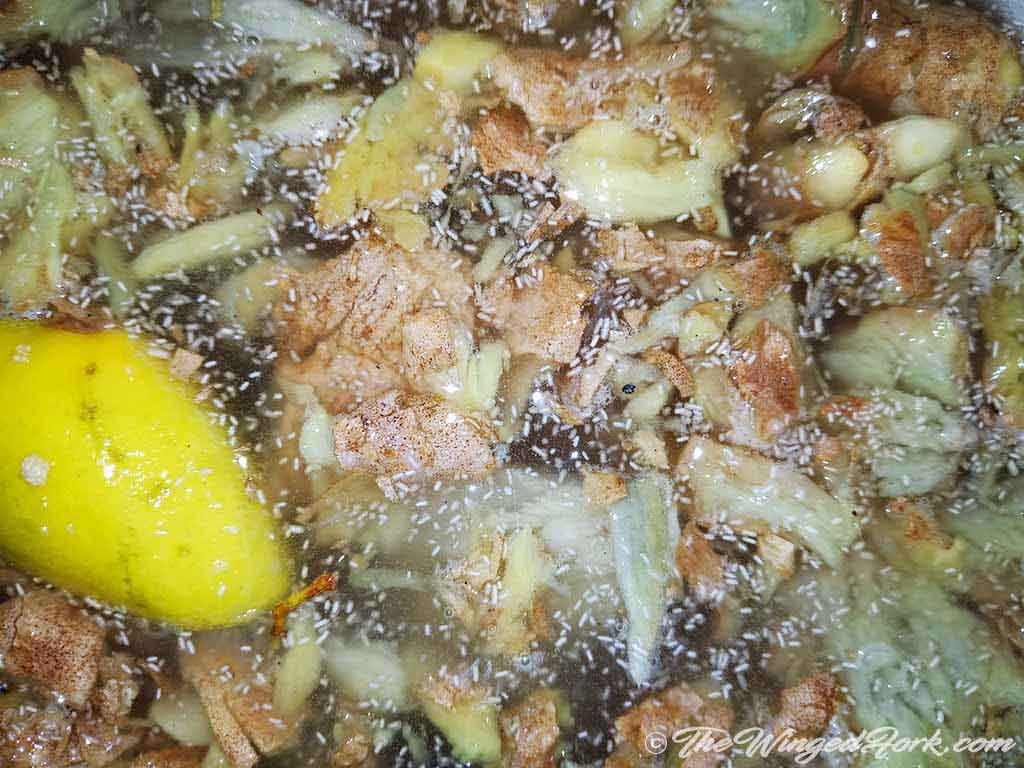
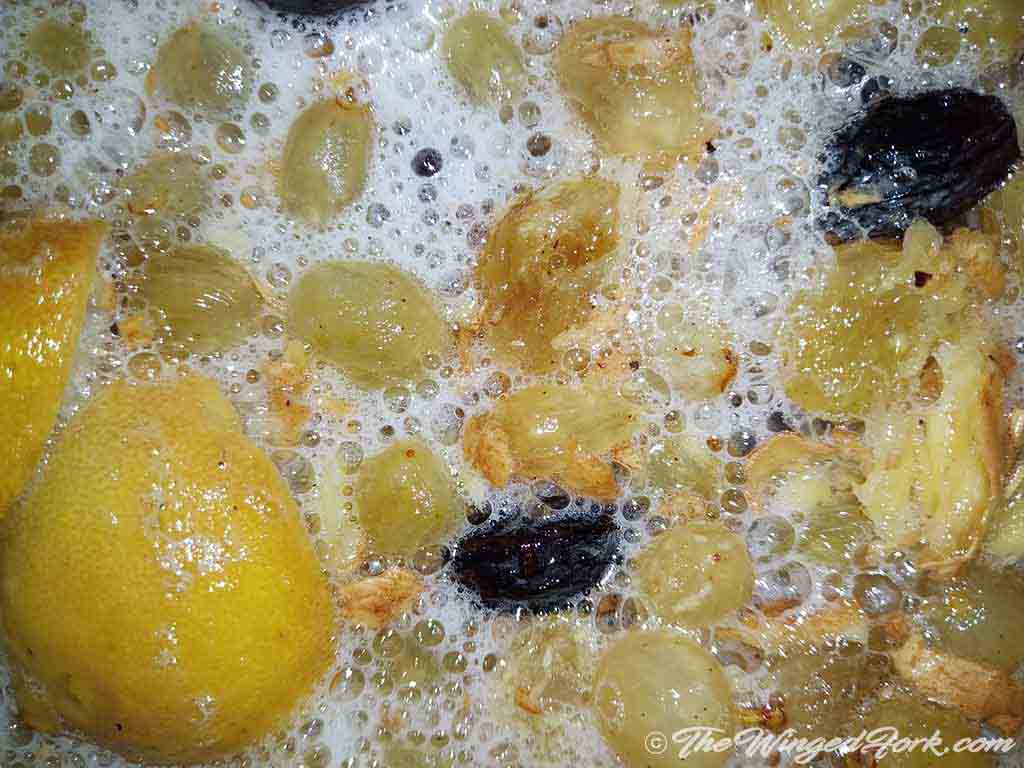
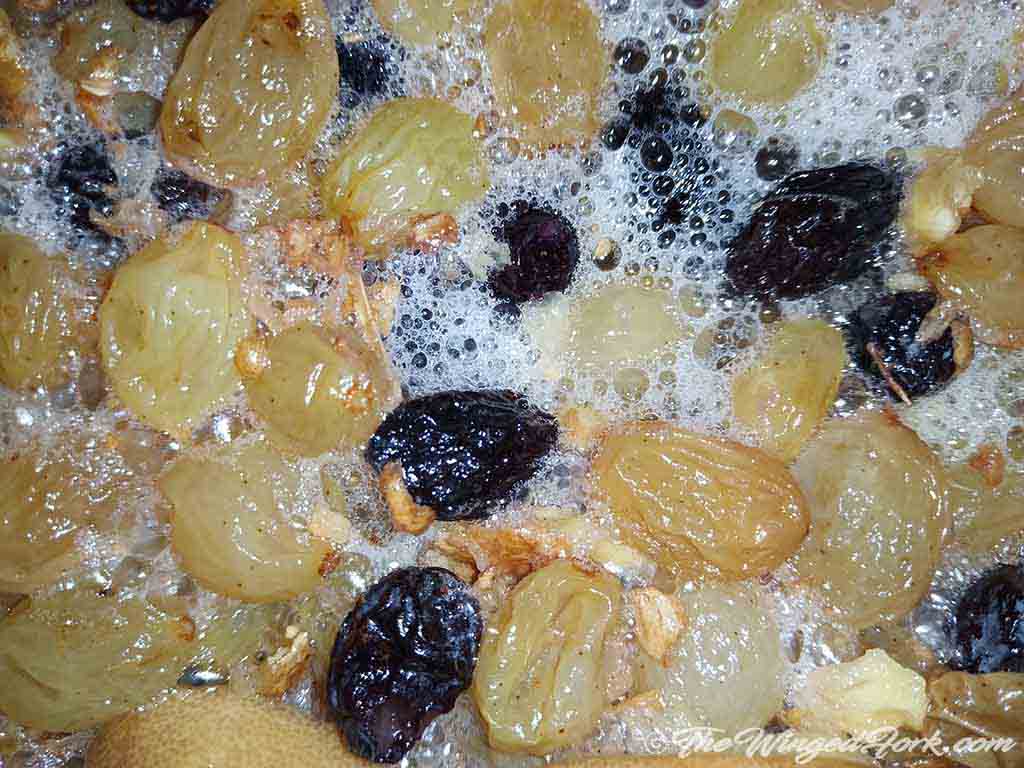
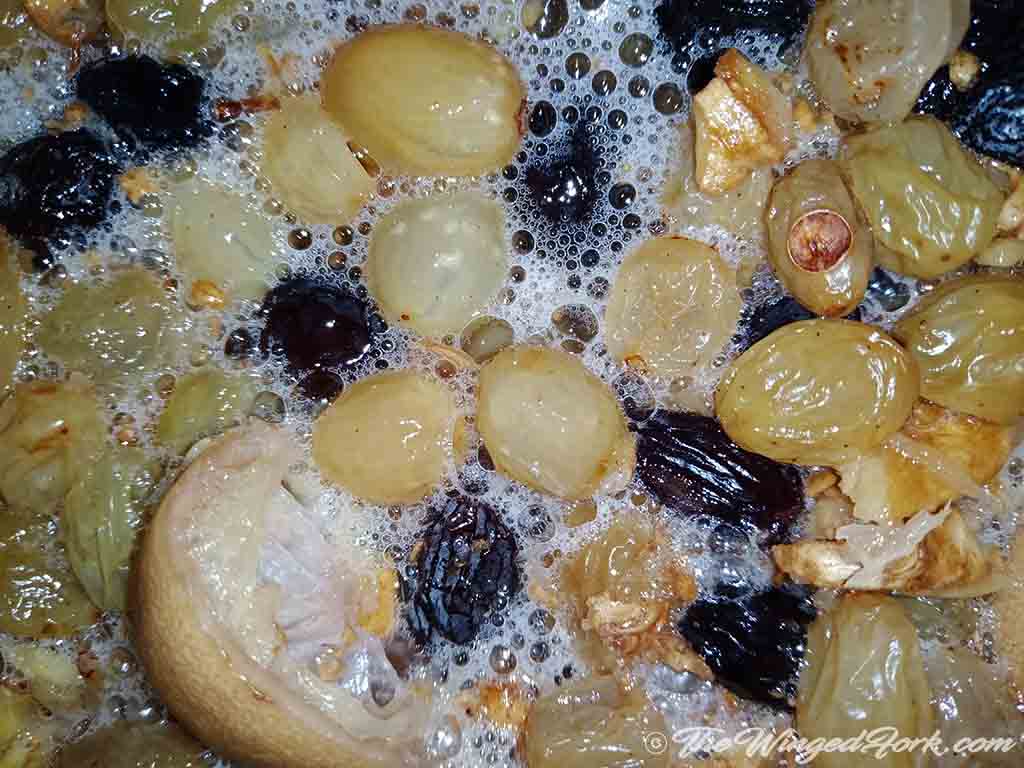
After stirring the wine for 7 days, leave it alone for 7 more days. Then strain the wine through a muslin cloth and bottle the wine. Wait for a few weeks before you drink the wine. If you can’t wait, the wine is perfectly good to drink immediately too! Go ahead and have a taste!

This pic above is of the ginger wine we made using only sultanas. You can see the earthy brown color.
The pics below are of the ginger wine we made using raisins that was racked for a few weeks using a quarter teaspoon of baking soda. The clarity is amazing. Doesn’t my sister‘s black and white picture below it look amazing?



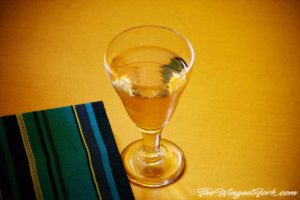
Spicy Homemade Ginger Wine
Click the stars to add your rating! Left you don’t like it, right you love it!
Ingredients
- 500 g Sultanas or Raisins (See notes.)
- 500 g Ginger Bruised
- 1.5 Kilogram Sugar
- 15 g Active Dry Yeast 15 g of any regular active dried baking yeast. Or 1 sachet (7 g) wine yeast. See notes.
- 2 Tablespoon Lemon Juice
- 4.5 l Water
Optional Flavors
- 1 Lemon Skin or
- 2 Orange Skins or
- 2 Dried Red Chillies
Instructions
Prepare Your Equipment
- Sterilize your jars, buckets or demijohns and spoons by washing with boiling water.
Prepare the Ginger
- Wash and clean the ginger as needed.
- Bruise the ginger with a pestle and set aside.
Proof The Yeast
- Warm about 100 ml of water and stir in 2 teaspoons of sugar. (Deduct this amount of sugar out of your main sugar.)
- Add in the yeast and leave it aside for 10 minutes.
- After 10 minutes, the yeast will be bubbling wildly and is ready to add to your wine bucket or ceramic jar.
- ((This step of proofing the yeast is not necessary. If you're certain the yeast is active, you can just throw the yeast into the must after adding all the ingredients for the wine must.))
Prepare The Wine Must
- While the yeast is proofing, prepare the rest of the ingredients.
- In a ceramic jar or demijohn, take the sugar, bruised ginger, lemon juice, and sultanas (or raisins). (Both raisins and sultanas do the same work of feeding nutrients to the wine, si it doesn't matter which you use.)
- Add the remaining 4.4 litres of water into this ceramic jar or or wine bucket and stir all the ingredients together.
- Depending on the flavor you want, you can now also add in the lemon skin or orange skin or dried chillies. If you do not add any of these optional ingredients, it's fine too. The wine will have a spicy ginger taste.
- Once the yeast has finished proofing, add it to this mixture and stir again.
- Cover with a lid and leave overnight.
- For the next 6 days, stir daily every morning.
- On the 7th day, test a bit of the wine and check if you need to add a bit more sugar to make it stronger.
- Leave the wine aside for another 7 days.
Strain and Rack the Wine
- On the 14th or 15th day, use a sieve or muslin cloth to strain the wine into a stainless steel pot or another demijohn.
- Bottle the strained wine and leave aside for a few weeks or months before shifting to new bottles again.
- Optional Step: Take out a bowlful of wine and mix with half a teaspoon of baking soda. Once mixed add a few tablespoons of the wine to each bottle and let is rest for a few weeks. This will both clarify the wine and reduce acidity.
- You can see the pics showing the different stages of clarity of the ginger wine in the post. Of course, if you don't want to wait for the wine to clarify, you can easily drink and serve the ginger wine once you've bottled it. It's up to you. Cheers!
Please click to rate the recipe! Left you don’t like it, right you love it!
Video
Notes
- You can use either sultanas or raisins or a mixture of both in any amount since both do the same job.
- If using wine yeast, 1 sachet (7 g) of wine yeast should be enough. Follow the instructions on the packet.
- Try to use lemons and not sour limes as they’re zestier and less acidic than sour limes.
Stuff You Might Want to Use
Nutrition (Per Serving)
Disclaimer: Nutrition Information per serving is estimated by a third party software based on the ingredients used, and is for informational purposes only. It will vary from product to product, based on methods of preparation, origin and freshness of ingredients. Please consult the package labels of the ingredients you use, or chat with your dietician for specific details.
This printable recipe card is for home use only. For more recipes head over to AbbysPlate.comTips and Tricks to Make Ginger Wine
- Use sultanas if you want a reddish wine, use raisins if you want a clear wine.
- You can use Indian yeast brands such as Blue Bird or Crown, but I prefer using stronger yeast such as the French Saf Levure or DCL Yeast.
- If using wine yeast, 1 sachet (7 g) of wine yeast should be enough. Just follow the instructions on the packet.
- Add lemon skins or orange skins for a light fruity flavor. If you want wine with a spicy kick, use dried kashmiri chillies.
- Rerack the wine after 2 weeks or a month to remove the dregs. That means, change bottles and get rid of that stuff that settles at the bottom.
- The longer you leave the wine to rest after making it, the better it tastes.
- In case you want to give it a go, our reader Lynn tried the recipe using organic ginger juice and says it turned out pretty good too! (Just make sure there are no additives in the juice.)
Things You Can Do With Ginger Wine In Summer
- You can use this wine to make ginger wine soda with a number of additions.
- Or you can make a ginger lemon spritzer or a ginger wine lime and mint spritzer.
Bonus Tip: I’ve had quite a few questions about making the wine last minute and making it faster for Christmas and other family dinners. If you’re in a hurry and wish the wine was ready quicker for a celebration or dinner or even for Christmas, here’s what you can do. Follow all the steps till day 7. On day 7, kill all the yeast and stop the fermentation process. Do this by adding a tsp of baking soda to the entire batch and leaving it alone. The next morning, bottle the wine and it’s ready to serve. It won’t reach the 8% to 15% that we usually do, but it will reach a decent 4% to 8% and everyone will still love it!
Questions about making your own Ginger Wine
Can We Use Any Other Fruits Instead Of Ginger?
Yes, you can use any other fruits, but you’ll need to double the amount. So for 500 grams of ginger, use 1 kg of pineapple or strawberries or any other fruit.
Can We Skip The Raisins And Sultanas?
Yes, you can skip the raisins and sultanas, but the alcohol content of the wine might be a few % weaker than this one.
If you want our traditional East Indian recipes on hand, the Abby's Plate Cookbook Series books are available online or in-store in most countries.
Latest Book:
East Indian Celebration
Festive Recipes from Abby's Plate
See the full list of books here!
Other Recipes You Might Like
- Vindaloo Recipe, the best pork!
- Marzipan chocolate Easter eggs
- Love apple pickle
- Mustard Paste Recipe
- Tripe Curry Recipe
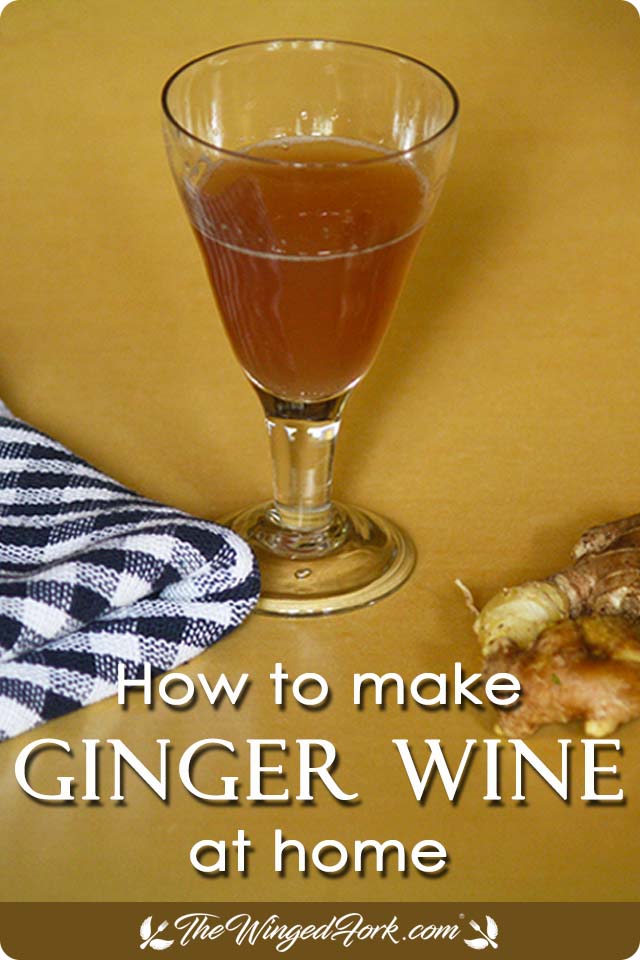
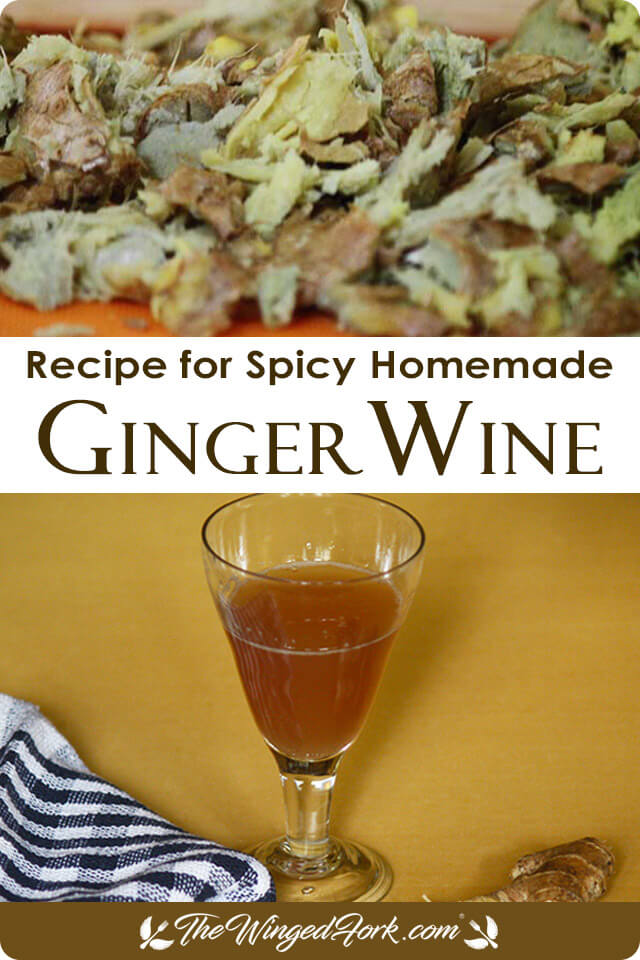
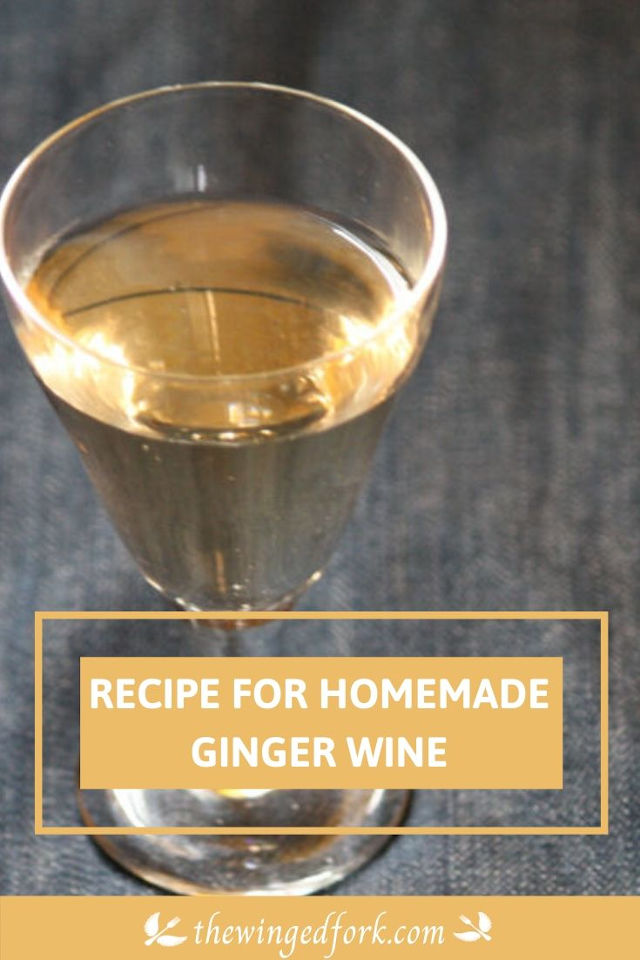

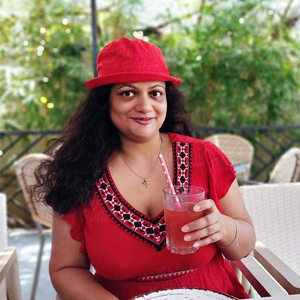
I’m an East Indian foodie and travel blogger from Bombay, India. I love food, wine, and sharing my culture’s ethnic East Indian and traditional Indian recipes. You’ll find more info about me here!




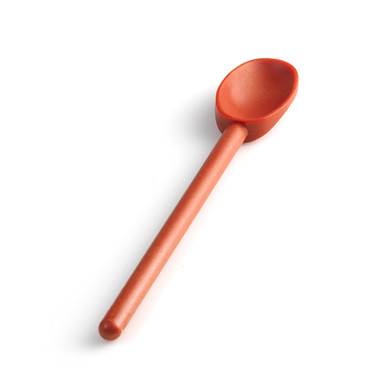

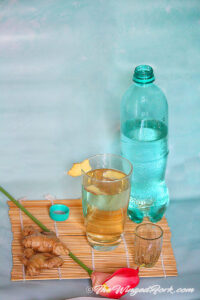
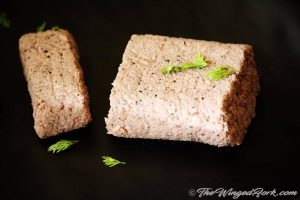
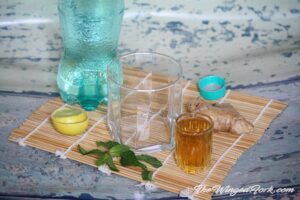
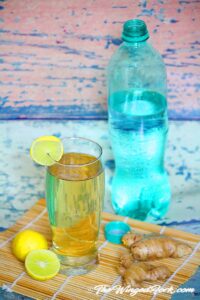
Hi Abby,
Wrote to you earlier.
It’s been 14 days since I started. Today I’ve drained the wine and squeezed the juice out of the ginger and raisins.
However the wine is tasting slightly acidic. I haven’t altered anything in the ingredients.
The barni cover was kept loose and well covered with a cloth to prevent any kind of insects entering.
What do I do?
I had read in previous comments something about baking soda…any help? And how much for half the quantity of the recipe?
Hi Errol,
Add less than a quarter teaspoon of baking soda to wine and let it rest for a few weeks. It should be fine after that.
Hi Abby,
I did like you suggested and added the baking soda.
It has cut the acidity level as needed.
About the taste I’m not sure if I’ve got it right, as frankly, I haven’t tasted Ginger wine as yet. I just wanted to try this tempting recipe
Is it supposed to be sweet like the homemade grape wine? Bcoz I haven’t added any extra sugar. Just stuck to the measurements in your recipe.
Cheers !!!
Hi Errol,
There is a sweetness, but not to the same degree as the grape wine. The ginger wine will taste like the grape wine, but better!
Cheers!
Hello Abby,
Padmaja here. My ginger batch is now on day 8. I understand I should let it sit (not stir it) for another 7 days. – I took a small taste of it. It’s YUM! Spicy and perfectly sweet. But a bit watery. Will it get (a bit thicker) wine consistency over time? My 2nd question: should I put a tight lid on it for the next 7 days? Or leave it with the muslin cloth cover? Lastly, I didn’t have big ceramic jars. So made both Raisin wine (Day 3) & Ginger wine (Day 8) in a big Stainless Steel containers. Does it make a difference in taste? (ceramic vs SS).
Pl. let me know your feedback when you have the time. Thank you Abby.
Hi Padmaja,
You’re probably thinking of the sweet syrupy Indian wines. This isn’t like that. It’s not syrupy, but it’s strong. As long as it’s strong you’re good. If by watery, you mean it’s fika or not strong, then we’ll have to have a second look at your ingredients.
Either the muslin cloth cover or a loose lid is fine for the next 7 days.
And nope, no noticeable difference with the containers.
Hope that helps,
Abby
Thank you Abby for taking the time to respond to my query (and every other query).
I just took a taste of my black & gold Raisin wine (day 15) too. Both my ginger wine and Raisin wine taste awesome. I may have made a mistake adding just a cup more water perhaps :\.. So ‘watery’ as in more water in it than it should. But the taste is great. For the next batch, I will invest in a ceramic container and a set of proper measuring cups set. ;).
Thanks, Abby for the awesome recipes. Be well and spread joy as you always do!
Glad to hear that!
Hi Abby,
Today is day 7 and, on tasting the wine, I found it really acidic and not sweet at all. Please help. I’ve made a gallon.
Hi Monisha,
If it’s too acidic, it could either be because the ginger was off or because the yeast have gobbled up all the sugar.
If it’s a ginger problem, the only thing we can do is use the wine for cooking and make another batch.
If it’s a yeast problem, just add in about 100 or 150 gms or so of sugar and continue as usual. This will reduce a bit of the acidity, but the rest of it can be neutralized on Day 15 when you add the baking soda. Hope that helps.
Thankyou so much!
Hi Abby.
I’ve just put together everything for the ginger wine in a barni.
I didn’t think I would need to message you, since about 2 weeks ago I went through all the queries and your prompt and well explained replies.
However, just now, after reading the latest query by Monisha… I too have made half the quantity and logically I’ve halved all the ingredients including yeast @12-13gms.
Now reading your reply about 3/5th of the original yeast quantity (15 gms) would it make any difference?
Should I just add 2 more grams of the yeast to the mixture and stir ? Or should I just leave it at that?
Will appreciate your confirmation ☺️
Hi Errol,
If you’ve already started fermentation two weeks ago, don’t worry about it. You could just do a smell and taste test to make sure you’re on track. If you’re not happy with the alcohol content, you can add the extra yeast, and let it ferment for a week or so longer. But if it looks good to your nose and tongue, just leave it be and adjust the measurements for the next batch. Abby
Hi!
This is my first time making wine and, would like to start with a small batch. Can I just divide all the proportions given by 2?
Hi Monisha,
Yes, you can divide all the ingredients by 2, except for the yeast. Yeast works on different rules, so for the yeast, probably do about 3/5ths the original amount. Thanks!
Thankyou so much
Thank you Abby! This recipe is just so yum!! The wine has come out really well. Going to make some more 🙂 Happy, happy me!!
So happy to go thro yr recipe n all yr replies to d comments. I hv made grape wine but did not try ginger. Will try it soon.
HI ABBEY, i do alot of wine making so i thought i would try your ginger wine, just finished making 5 gallons and the taste is to die for, thank you so much, i only make 5 gallon batches, so next is ginger and strawberry and ginger and rhubarb, so glad i came across your web site, regards Shaun
Thanks Shaun! Would love an update on how the ginger and strawberry turns out. 🙂
HI, ABBEY a update on my strawberry and ginger wine, the colour is a golden copper colour, the taste is , well you can taste the strawberry in it, it’s pretty strong. and i think its the best wine i have made, im a big fan of wine mixing with ginger, and to be honest its helping me with my stomach problems ( a long story with lots of pills) so i owe it all to your ginger wine , thank you very much ,
Sounds tasty! We haven’t mixed strawberry and ginger yet. So we’ll try that soon. 🙂
If you have stomach issues, try a mix of dried rose petals and ginger wine. It tastes good and rose petals are generally cooling for the system.
Hi Abby,
My first attempt at winemaking. Have followed your recipe closely and used sultanas.
I didn’t proof the yeast though as it was active dried type. However, I am on day 3 of stirring it and it is hardly fizzing, is that okay?
Thanks for your kind assistance,
Paul
Hi Paul,
The first few days, the yeast is usually super active. So there might be a problem.
Try and check these few things – if the sugar wasn’t enough, or if the sugar was all eaten up, or if you need to add more yeast.
First thing in the morning, just before it’s time to stir the must, try adding about 100 grams of sugar to it. If it fizzes for a minute or two, it means the yeast are active and the sugar wasn’t enough, and you need to add a lot more sugar. If the yeast doesn’t fizz, add in another teaspoon of yeast, and hopefully, it’ll start fizzing in a few hours. If it does, it means you need to add more yeast.
Let me know if this works, and we’ll take it from there.
Abby
Oh thanks, brilliant!
Hi Abby, thanks for your marvellous recipe! I made 2 gallons which are nicely bubbling away in their Demijohns.
My question is this, is it ok to ‘blend’ the ginger roughly in a blender rather than bruising it with a pestle and mortar? I only have a medium size pestle and mortar and was getting quite weary halfway through the last lot of ginger and did just that with rest of it. Do you think it’ll matter if I use the blender for my next batch?
It really is an excellent recipe….how do I know that? I keep on having a taste from one demijohn just to make sure it’s doing alright! It’s so warming!
Thanks again!
Hi Fanny,
Yes, a rough run through the blender or food processor will work just fine. 🙂
Abby
Can I ferment the wine in an airtight glass jar instead of a ceramic one?
Hi Catherine,
You can use a glass jar, but not an airtight one. It needs to be ever so slightly open at the top, or have an airlock like the demijohns used for wine. Happy fermenting!
Abby
Thank you for this recipe. I made it yesterday and gave it a good stir this morning. It smells lovely and the sultanas have plumped up in the mix, which got me thinking if I could use them in another recipe once I strain, or will they be off. It reminded me of what my mum use to do with dried fruit in her ‘cup of tea’ cake and Christmas cake (with alcohol).
This morning I went through all the comments and am impressed with your commitment to feedback, but also now see that the results should be like a table wine, rather than a ‘Stone’s or Crabbie’s’ type Ginger wine, which I had been looking for when I came across your recipe.
However, I may have gone a bit overboard with my extra flavours, as I added the lemon zest too, orange juice and zest, plus a couple of chillies from my garden, so I will report back on the finished product.
I also may have added too much yeast, as I had a small block of fresh yeast to use up and was not sure how live it was, so added a small spoon of dried too. Do you think I will need to give the mix more sugar to eat up, or will that make it too strong.
Questions, questions…I am excited about this
Thanks again
Heya Debs,
We soak dried fruit in alcohol too. Have part the batch ready for Christmas 2022 already. 😉 But, the sultanas from the wine cannot be used for food ie cake as they’re mixed with yeast and other left overs. Plus you have to remember, that they’re technically decaying fruit, so best not to eat.
You could use them for a second run of the wine. We do this. Use half of the ingredients you used earlier with the leftover sultanas. So say for this recipe it would be the leftover sultanas and 0.750 kg Sugar, 1 tbsp Lemon Juice, 2.25 l Water, and so on. Procedure stays the same. The only problem with second runs is that the wine is not as strong as it should be. But it’s still good for cool drink or for use in cooking.
For the yeast, try this. Just before your regular time to stir the wine, add in a tablespoon of sugar, and wait. If you see the yeast go crazy over it – extra fizzing – it means they want more sugar and you can add that it. And really, who cares if the wine turns out stronger?
Let me know if you have any other questions.
Abby
Great!!! It’s given in detail. How long would it keep??
Thanks.
I’ve kept a few bottles for 2 to 3 years, but ginger wine should last a lot longer. 🙂
Hi there! Thanks so much for this great recipe! Just finished making our first batch. We realized in the end that we added half the amount of water we needed to (because of the size of our container). Can we add this water in end (when we strain it)? Or will this mess up the composition?
Thanks in advance!
Hi Deyvika,
You’d have to go by taste here. If the wine seems too strong or too sweet, you can add a bit of water (maybe a pint or two max). But the best option is to not add any. Best leave the wine as it is. 🙂
Abby
Thank you Vyola! That means a lot.
Hi Abby…finally did make the ginger wine….just a bottle, but it has turned out beautiful..used red chilli’s .
It turned out so clear and tasty…thank you
You can give ur recipe a 5★
Thank you
Starting another lot tomorrow!
Thank you!
Also was reading the comments from the message below….how do you reach a Stones ginger wine taste??!!!
Thanks any extra tips?
Hi Vyola,
I don’t really know. We haven’t tried experimenting with flavors to reach a taste similar to Stones ginger wine yet. We’ll put that on the to-do list, which is quite long. 😉
Hey Abby, after trying out my first attempt with your ginger wine recipe. (I grated my ginger)
Thanks to your recipes and tips have started enjoying experimenting with the wines in small quantities of course, have made apple wine, apple strawberry wine and orange wine…using almost the same method & ingredients that u have in your recipe. only changing the main ingredient of ginger to the apples, strawberry, beetroot or oranges! And they have turned out superb!
Thank you
⭐️⭐️⭐️⭐️⭐️
That’s awesome Vyola! Yes, the base recipe for most wines is the same. Glad you’re enjoying it!
Hi Abby,
Somehow my wine is nice and clear but it has an sharp over powering taste of ginger. I can’t seem to taste any of the spices.What do you think is gone wrong, please advise.
Hey Sylvia,
You haven’t done anything wrong here. Some local varieties of ginger are a lot stronger than others, plus there are other factors like age, freshness, etc. We’ve had a few batches that really kick and don’t taste like anything else. The only thing you can do is reduce the amount of ginger a bit next time or double up on the spices, sort of personalizing the recipe for the next batch.
For this batch, you can use soda as a mixer if it’s too strong.
Hope that helps a bit.
Abby
Hi..will def try this…but am really impressed by the way you have answered all the queries.
Thank you
Thank you let you know how I get on
Hi
Please can you tell me the best type of sugar to use white/ brown. Thank you
Hi Annette,
We use regular white sugar (table sugar) to make the wine.
Abby
Hi Abby
Was excited when I saw the ginger wine recipe and I am making it. Just have a question when I stir the wine should I mash the raisins or just stir it.
Hi Pearl,
There’s no need to mash the raisins. Just stir them. 🙂
Cheers!
Hi Abby! It’s day 8 and my wine is still fizzing. Is that normal? Should I stop stirring the must every day and just leave it for another 7 days? I’ve got the lid covered with a muslin cloth.I’m worried that if I rack it after 15 days, given the amount of carbon dioxide in it the bottles might explode. Should I let it ferment for longer than 15 days to let the gas escape? Incidentally it smells gorgeous! I added orange peel and Kashmiri chillies. And it certainly has an alcoholic kick to it!
Hi Jo,
The fizz will start to die off around the 11th or 12th day. If it’s not completely gone by the 15th day, you can strain the wine and add it back to the jar for another week or two. There’s no problem with that. But you don’t want to leave the ginger in the wine for more than first two weeks. So strain it and then add it back to the jar.
Another method we use sometimes is, if you have place to leave the wine bottles standing up in the cabinet, then you can rack the wine and cork it loosely so that the excess gases escape.
Let us know how it goes. 🙂
Abby
Is it possible to freeze the wine before running it through a muslin cloth.
Then, put the frozen liquid over a muslin cloth and let it defrost through a colander very slowly and the droplets of wine should be totally clear? (There may be colour, but it should be clear).
I saw Heston Blumenthal do this with chicken soup consommé and he explained the easiest way to get a totally clear soup!
Hi Steve,
There’s a difference between food and drink. Yes, companies use cold stabilization to remove tartaric acid from lower quality wines, but that’s not a process that can be done at home.
When it comes to regular wine, once it freezes, the water content in it expands and it can burst out of the bottles. But that aside, the slush produced will taste off, more like a really cheap version of the wine that you froze. And that will be best suited to cooking instead of drinking. It’s best to let the homemade wine clarify naturally over time. Or if you’re in a hurry, use either gelatin, egg shells, or a tsp of baking soda. (The baking soda also gives it a nice fizz.)
Also, if you freeze leftover wine as cubes to add to a dish, it might taste okay. People do this. We don’t. Let us know if you have more questions!
Abby
What would the alcohol content be??
It really depends on the quality of your ingredients, and how your ingredients react to each other. Our wines turn out pretty potent and average above 10%, but in general homemade wines can have an alcohol content ranging anywhere from just 5% to as high as 15%
Hi Abby – going to try this. Never made wine before. A few questions: Is the final product like regular dry wine or more sweet dessert wine? What is the right temperature to store at during the 15 day process? When we bottle them at the end, do we have to seal them airtight, or will cork do? Also, after bottling, do we need to keep it in the fridge or outside just like regular wine? Thanks!
Hi Jacob,
It’s almost like a regular table wine with just a hint of sweetness. The best temperatures are around 20 to 30 degrees Celsius. So as long as your demijohn or jar is in a cool dry place, it’s fine.
We just cork the bottles. There’s no need to refrigerate the wine. If stored properly in a cool dark environment, (we store it in a stone cabinet), the wines last for months, or even years. Hope that answers all your questions.
Abby
I’m on day 15 of attempting to make this wine. But it looks and smells more like ginger beer (cloudy) in colour than above. Have I done something wrong?
Hi TJ,
It’s okay if it’s cloudy at Day 15 as long as it tastes good. Strain it into another jar and leave it alone for a week or more to let the dregs settle before you rerack it (meaning simply change bottles and throw out the sediments).
But if you want the wine to clarify sooner, you can add about half a teaspoon of baking soda to the wine jar before bottling it. This will fizz for a bit, and that’s fine. But it will get the dregs settled quicker and might also add a slight tasty fizz to the wine, just like ginger beer.
But more importantly, clarity takes time, you can enjoy some of the wine but leave a few bottles aside where you can’t reach them, so that you can come back weeks later to find clear wine.
Abby
Currently making this wine for my family, just had a question, I am using a big jar and have left the lid on, is that correct? Or should I leave the jar open with a cloth over top to let out carbon dioxide after day 7 when I stop stirring?
Hi Tracy, both ways work. We usually just leave the lid on loosely fitted so that there’s just enough of a gap for the carbon dioxide to escape without any insects falling in. But if you prefer to cover it with a cloth, that works too! Happy tasting in December!
Why does my wine turn sour? I’m going to give it a try again following your steps.
Hi Kevin,
Was the ginger used damaged? Is it stored in a good place? Was anything wrong with the sugar? Did any flies, bugs, sticks or leaves drop into the wine? Did any acetobacter from the air get into it? Wine can get sour for a lot of reasons. You can salvage the wine by putting it back in a demijohn or glass jar, add a teaspoon of baking soda to it and leave it alone for a 2 or 3 weeks. (Please make sure you use baking soda and not baking powder.) At the end of that, the baking soda should have neutralised most of the acidity in the wine.
There is also the chance that acetobacter got into your wine and turned it into vinegar. If this happened, just use it for cooking instead. And let me know if you have any questions.
Abby
Hi Abby, the baking soda took care of the acidity in the wine… But it’s been 4 weeks now and tastes a little too mild. Can I add more sugar to increase the alcohol content or should I just leave it in peace and it will mature into good strong ginger wine?
Hi Sheryl,
The ideal time to add the sugar would have been around Day 7 when the yeast were still active. Or during the following weeks before adding the baking soda. Once the baking soda is added to the wine, in addition to reducing acidity it also kills off the remaining yeast. So the wine will mature, but in this instance, it won’t get stronger. How do you feel about using this wine for cooking and starting a new batch?
Abby
Do I have to heat up the water and mix the sugar to melt the sugar or is the daily stir to dissolve the sugar?
Hi Jeanette, the stirring is to degas the wine. You don’t have to heat up the water to melt the sugar. The sugar used will be consumed by the yeast and will turn into alcohol within a week.
((The only reason you might want to heat the water before using it is if you live in a region where the water is not potable. In this case, boil the water and let is cool down completely before using it.))
Ginger wine takes a while to ferment, so start some now and it’ll be there to warm you up come winter.
Hi,
Do you sell the ginger wine too?
Ann
Hi Ann, We used to sell food and wine about 8 years ago. But we’ve stopped since. There are a few people in our group on Facebook who sell wine and East Indian food. Come join us there and ask. Luckily you might find someone in your neighbourhood. https://www.facebook.com/groups/AbbysPlate/
Glad to know that Colin! 🙂
Just finished bottling. It tastes spicy. Dad loved it!
Big change in color with the last few images. How long did you rack it?
Hi Cynthia,
The clear wine had been racked for almost 4 weeks. We sometimes rack it for 2 weeks, and sometimes go all the way up to 6 months. It depends on how often we have visitors. But of course, the longer you rack it the better.
Hi. I am looking to make this Ginger wine soon as i just harvested ginger from my garden.
Can I use a huge glass bottle to make and keep the wine?
After making the wine, does the cap/stopper have to be closed very tightly? Or loosely because of the gas made with the yeast?
Hi Susha, yes, you can use a huge glass bottle. You’ll need one that takes 2 litres or 4 litres or more, depending on the amount of wine you’re trying to make. The cap needs to be loosely closed as it mimics the operation of an airlock that lets carbon dioxide out but prevents oxygen from getting in. Hope this helps!
Thanks for a great recipe, a 5l pineapple and ginger wine is in the making!!
BTW what yeast do you use?
Hey Prasan,
You can use any yeast with these recipes, be it wine yeast or baking yeast. For the last few years I’ve been using DCL Yeast and SAF Yeast because they’re pretty strong/active. Of course, when I can’t get a hold of those, I’ve also used Bluebird, Eagle, or any regular baking yeast to make the wines! Back in our grandparents times, there was no distinction between food yeast and drink yeast.
Happy wine making! Come back and let us know how it goes!
Abby